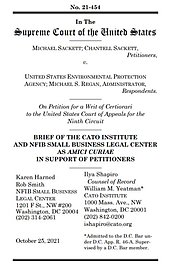In 2007, Michael and Chantell Sackett became mired in this regulatory morass. Their plans for a family home were put on indefinite hold when the government claimed that soggy parts of their property are subject to federal regulation as “navigable waters.” The Sacketts, represented by the Pacific Legal Foundation, challenged the government’s jurisdictional determination in federal court, arguing that their homesite—which is bounded by permanent roads on both ends and has no surface water connection to any water body—cannot fall within the Clean Water Act’s ambit. Ultimately, the Ninth Circuit upheld the federal government’s jurisdiction. Now, the Sacketts seek Supreme Court review.
Today, the Cato Institute, joined by the NFIB Small Business Legal Center, filed a brief in support of the Sacketts’ petition. We urge the Court to take this case and “say what the law is” regarding the notoriously unclear reach of the Clean Water Act.



